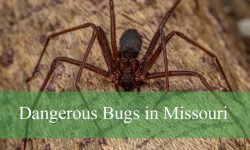Michigan offers an incredible variety of dragonflies, from tiny species like the Elfin Skimmer to large, powerful flyers like the Green Darner. These fascinating insects are not only beautiful to observe but also play a vital role in maintaining healthy ecosystems by controlling mosquito populations and serving as indicators of clean water.
This guide features 21 dragonfly species commonly found throughout the state. Each profile includes detailed information on identification, behavior, habitat, and seasonal activity. With a little attention and curiosity, you can start spotting these colorful creatures in parks, wetlands, and even your own backyard.
Common Dragonflies You Can See in Michigan
Eastern Pondhawk (Erythemis simplicicollis)
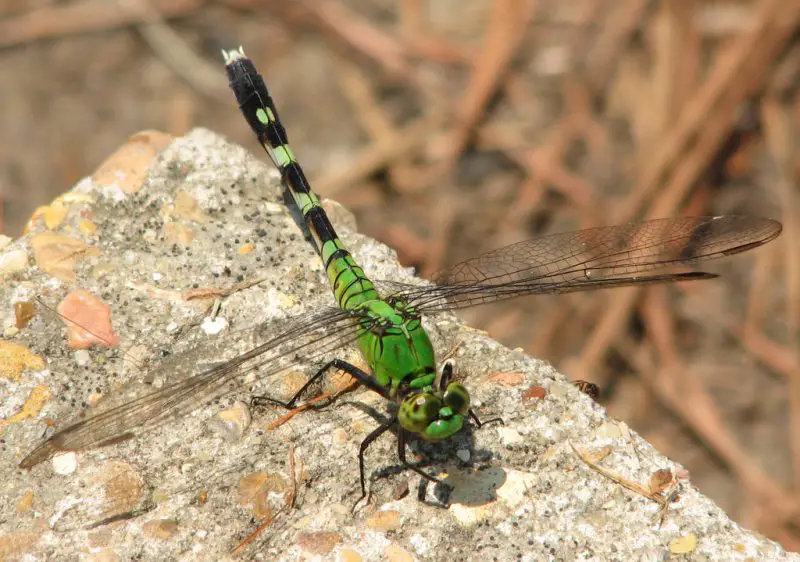
The Eastern Pondhawk is a striking and aggressive dragonfly commonly seen across Michigan during the warm months. Males are instantly recognizable by their powdery blue abdomen and green face, while females are bright green with dark banded abdomens. This stark sexual dimorphism makes identification straightforward in the field. Juvenile males resemble females before turning blue with maturity.
These dragonflies are voracious predators, often seen perching low near ponds, marshes, and still waters, waiting to ambush small insects midair. They are territorial and will chase away other dragonflies from their favorite hunting spots. Their powerful flight and agile maneuvering make them successful hunters even in dense vegetation or over water surfaces.
In Michigan, Eastern Pondhawks are typically active from late spring through early fall, peaking during the summer. They thrive in sunny habitats with still or slow-moving water. A fun fact: unlike many dragonfly species, both sexes of the Eastern Pondhawk are highly aggressive hunters, and females are known to devour males if mating does not go as planned.
Blue Dasher (Pachydiplax longipennis)
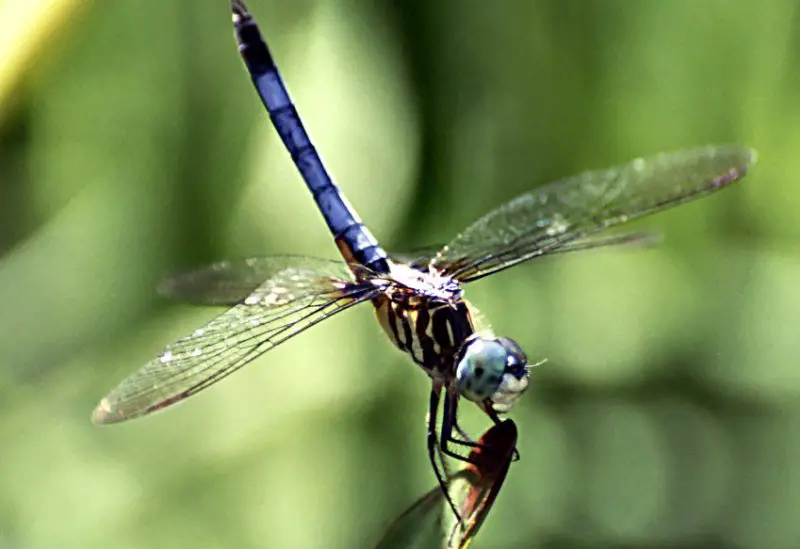
The Blue Dasher is a small but vividly colored dragonfly, easily found throughout Michigan near lakes, ponds, and marshy edges. Males feature a bright blue abdomen with a black tip, contrasting with their green and blue striped thorax and piercing red or blue eyes. Females and immature males are more brownish with yellow stripes, which sometimes causes confusion during identification.
Blue Dashers are energetic fliers that often perch on reeds or twigs near the water, darting out to catch prey or defend their territory. They display territorial behavior, frequently engaging in aerial chases with rivals. Despite their size, they are agile predators and play an important role in controlling mosquito populations and other flying insects.
These dragonflies are usually active from June through September in Michigan, especially during warm, sunny days. They prefer shallow waters with abundant vegetation. A fun fact: Blue Dashers often tilt their bodies in a characteristic “obelisk posture”—pointing their abdomen straight up—to avoid overheating in the sun.
Widow Skimmer (Libellula luctuosa)
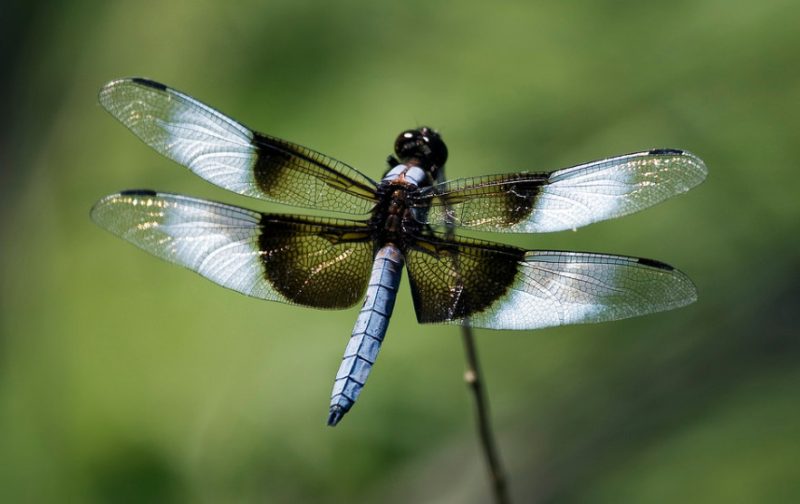
The Widow Skimmer is one of the most visually distinctive dragonflies in Michigan, notable for its broad black wing bands. Mature males have striking white patches on their wings and a powdery blue body, while females and immature males have dark bodies and only the black wing bands. These contrasting patterns make them easy to spot and identify.
Widow Skimmers favor open, sunny areas near ponds, lakes, and slow-moving streams, where they often rest on tall grasses or twigs. They are not as aggressive as other dragonfly species but still exhibit territorial behavior. Males patrol their territory in a slow, hovering flight, often returning to the same perch repeatedly.
In Michigan, Widow Skimmers are typically active from late May through August. They are most commonly found in the southern and central parts of the state. A fun fact: the species gets its name from the dark, mourning-like wing markings of the female, which early naturalists associated with the garb of a widow.
Fragile Forktail (Ischnura posita)
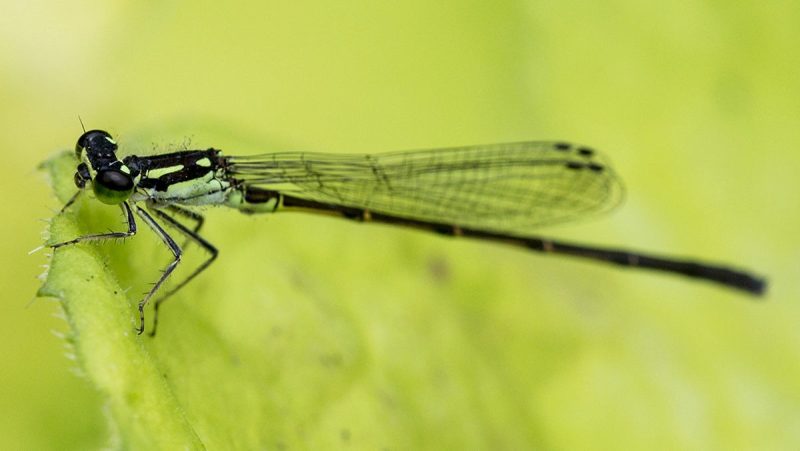
The Fragile Forktail is a tiny, slender damselfly found throughout Michigan, often going unnoticed due to its small size and delicate form. Both males and females have thin bodies and distinctive green shoulder stripes on a black thorax, shaped like exclamation marks. Males are generally black and green, while females can vary in color from green to blue or even orange.
This damselfly species prefers still waters like ponds, marshes, and the edges of quiet streams. Unlike dragonflies, Fragile Forktails often stay very close to vegetation and perch low, making them less conspicuous. They are not particularly territorial and usually stay in small groups or solitary. Despite their size, they are effective hunters of gnats, mosquitoes, and other tiny insects.
They can be found from late spring to early autumn in Michigan, with adults flying from May through September. A fun fact: Fragile Forktails are among the few damselfly species whose females may remain brightly colored even after mating, making them easier to identify throughout their adult lives.
Common Whitetail (Plathemis lydia)
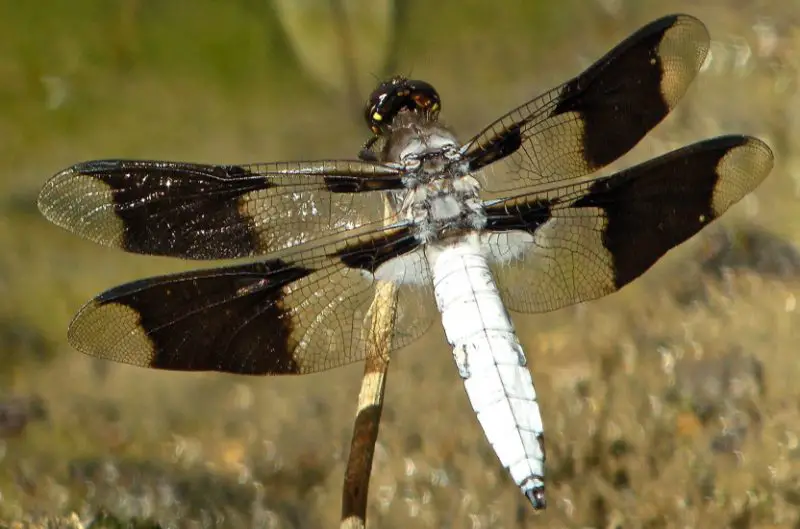
The Common Whitetail is one of Michigan’s most recognizable dragonflies, thanks to its short, stout body and chalky white abdomen in males. Females and young males have brown bodies with three white wing spots on each wing, while mature males have a single dark band on the wings and their namesake white tail, giving them a distinct, bold appearance.
These dragonflies are frequently found near ponds, lakes, and marshy areas with open banks. They are ground perchers and often rest on trails, rocks, or flat surfaces near water. Males are highly territorial and spend much of their time patrolling small patches of shoreline, chasing away rivals and attempting to attract females.
Common Whitetails have a long flight season in Michigan, often appearing from mid-May through September. They are abundant across the state, from urban parks to rural wetlands. A fun fact: unlike many dragonflies that perch on vegetation, Common Whitetails frequently land on open ground, making them easier to photograph and observe up close.
Eastern Amberwing (Perithemis tenera)
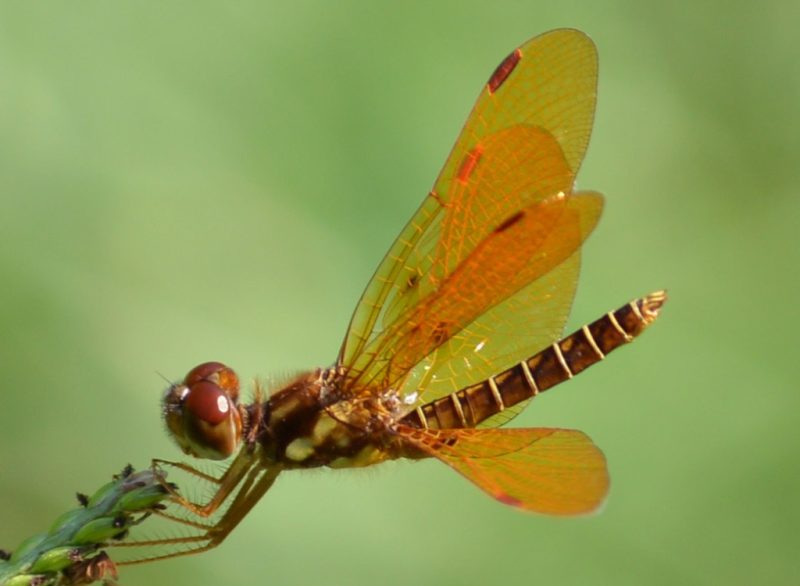
The Eastern Amberwing is one of the smallest dragonflies in Michigan, easily recognized by its golden-amber wings and wasp-like appearance. Males have orange-tinted wings and reddish-brown bodies, while females are duller in color with banded wings that mimic the look of a small wasp. This mimicry helps deter predators, making them less likely to be eaten by birds or other insects.
These dragonflies are commonly found near ponds, marshes, and quiet backwaters with abundant floating vegetation. They prefer sunny spots where they can perch and defend small territories. Males are often seen hovering over lily pads or landing on floating leaves, occasionally engaging in short, darting flights to chase rivals or court females.
Eastern Amberwings are active in Michigan from June through early September, especially in southern and central areas of the state. Despite their small size, they are confident and bold fliers. A fun fact: their wasp-like flight pattern and wing coloring are so convincing that even experienced birdwatchers sometimes mistake them for stinging insects at first glance.
Autumn Meadowhawk (Sympetrum vicinum)
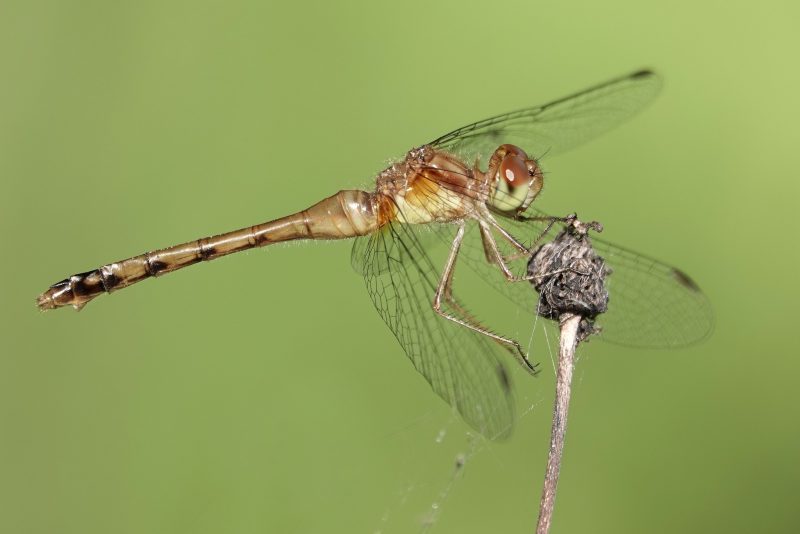
The Autumn Meadowhawk is a small, late-season dragonfly known for its bright red coloration and friendly behavior. Mature males develop a vibrant red body and red face, while females turn a duller reddish-yellow or golden tone. Unlike many other dragonflies, they often perch on people, fingers, and clothing, seemingly unafraid of human presence.
These dragonflies are most often found near woodland ponds, slow-moving creeks, and forest edges. They favor sunlit openings and are less tied to large open water than other species. Autumn Meadowhawks are frequently seen basking on rocks, logs, or bare ground, especially during the cooler months when sun-warmed surfaces help them stay active.
They appear late in the season, flying from August through November, and are often the last dragonflies visible before winter sets in. They are widespread throughout Michigan, including the Upper Peninsula. A fun fact: unlike most dragonflies, Autumn Meadowhawks can survive brief cold snaps and are even seen flying during mild November days in Michigan.
Common Green Darner (Anax junius)

The Common Green Darner is one of the largest and most widespread dragonflies in North America, easily recognized by its brilliant green thorax and long, blue abdomen in males. Females have a similar green thorax but can range from blue to brownish abdomens. Their size, fast flight, and vivid coloring make them a striking presence over open water.
Green Darners are strong migrators and are often among the first dragonflies to appear in spring and the last to leave in fall. In Michigan, they inhabit lakes, ponds, marshes, and slow rivers. They patrol high over open water or fields in sweeping loops, feeding on mosquitoes, flies, and other flying insects. They rarely perch for long, making them more often seen in flight.
In Michigan, Green Darners can be found from April through October. Many individuals seen early in the season are migrants from the south, while others emerge locally in midsummer. A fun fact: this species undertakes long-distance migrations similar to monarch butterflies, traveling thousands of miles between breeding and overwintering sites.
Comet Darner (Anax longipes)

The Comet Darner is a spectacular and uncommon dragonfly in Michigan, admired for the male’s intense red abdomen, which contrasts beautifully with its green thorax. Females are duller, typically showing a mix of brown and green tones. Their body shape is similar to that of the Common Green Darner, but the coloration and rarity make them stand out.
Comet Darners favor shallow, fishless ponds, especially those with dense aquatic vegetation and minimal disturbance. They are powerful and agile fliers, usually seen patrolling over small bodies of water or perched high in sunlit trees. Males are territorial and will aggressively chase away intruders from their breeding sites.
In Michigan, Comet Darners are most often reported from mid-summer through early fall, especially July through September. While they’re not as commonly seen as other darners, they are locally frequent in southeast Michigan. A fun fact: the species gets its name from the brilliant “comet-like” streak of red that seems to trail behind the male as it zips across the pond.
Shadow Darner (Aeshna umbrosa)
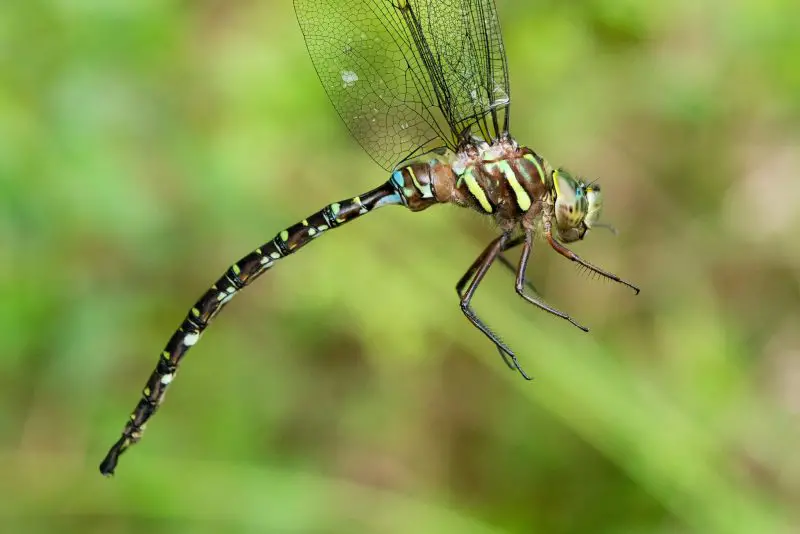
The Shadow Darner is a large and robust dragonfly, notable for its tolerance of cool temperatures and tendency to appear late in the season. It has a dark brown to black body marked with bright green or blue spots along the thorax and abdomen. Its wings are clear, and the eyes often touch at the top of the head, typical of darners.
True to its name, the Shadow Darner prefers shaded woodland streams, boggy ponds, and forest edges, where it patrols low and slow through dappled light. Unlike many other dragonflies, it remains active in cloudy or even drizzly weather and continues flying into the evening, giving it a reputation for being one of the last species on the wing each day.
In Michigan, Shadow Darners are common from late July into October and are among the final species observed before frost sets in. They are widespread across the state, including colder, northern regions. A fun fact: Shadow Darners are one of the few dragonflies that can thermoregulate efficiently, allowing them to fly in low light and cool weather conditions that ground other species.
Twelve‑spotted Skimmer (Libellula pulchella)
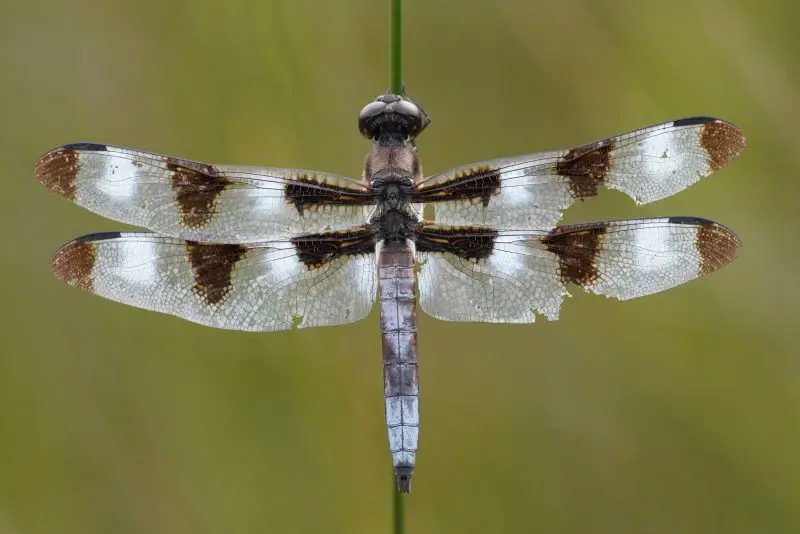
The Twelve-spotted Skimmer is a bold, medium-large dragonfly commonly seen across Michigan and much of North America. Males are instantly recognizable by their twelve black wing spots—three on each wing—and additional white patches between the dark ones, giving the appearance of bright checkered wings. Females and immature males lack the white spots but still display the characteristic black markings.
These dragonflies prefer calm, sunny habitats such as ponds, lakes, and marshy fields. Males perch on exposed twigs or tall grasses near the water’s edge, often returning to the same spot after patrolling their territory. They fly in wide, deliberate loops to deter rivals and attract females. Their slow, hovering flight makes them easy to observe and photograph.
In Michigan, Twelve-spotted Skimmers are active from June through August and are widespread throughout the state. Their abundance and distinctive appearance make them one of the most recognized dragonfly species. A fun fact: when in flight, the alternating black and white wing markings make them resemble fluttering butterflies from a distance.
Halloween Pennant (Celithemis eponina)
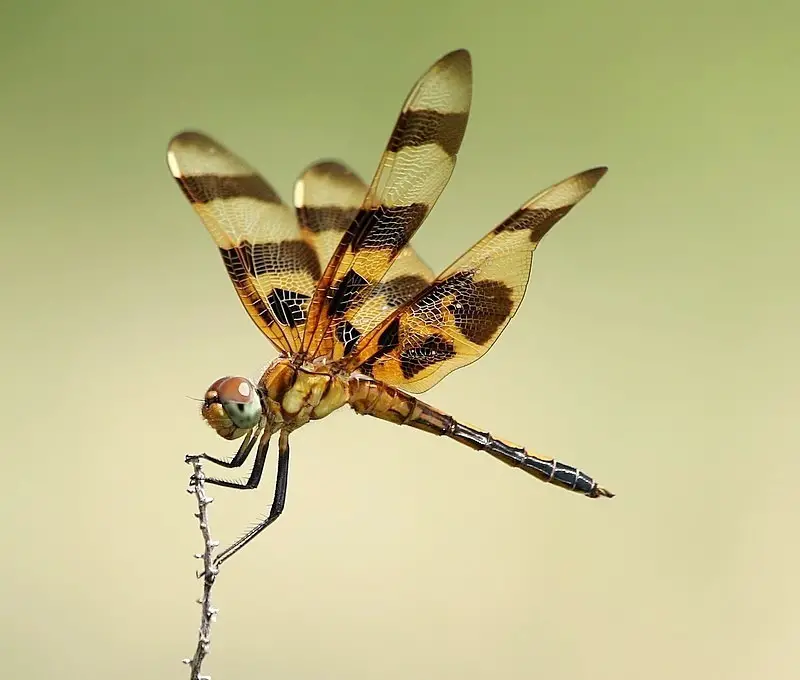
The Halloween Pennant is a colorful dragonfly named for its festive orange and black wing markings, which resemble tiny flags fluttering in the wind. Males have amber wings with brown or black bands and an orange-tipped abdomen, while females are similarly patterned but slightly less vibrant. Their delicate, fluttery flight and upright perching posture make them stand out among dragonflies.
This species thrives in open, grassy wetlands, the edges of lakes, and calm ponds with abundant vegetation. They are known for perching high on reeds or stems, swaying gently in the breeze like tiny pennants. Unlike more aggressive dragonflies, Halloween Pennants are less territorial and often share perching spaces with others of their kind.
In Michigan, they are typically seen from June through September, especially in southern and central regions. They prefer hot, sunny weather and are more likely to be spotted on still days. A fun fact: Halloween Pennants are among the few dragonfly species that can mate in strong winds, thanks to their highly flexible perching strategy and efficient wing structure.
Calico Pennant (Celithemis elisa)
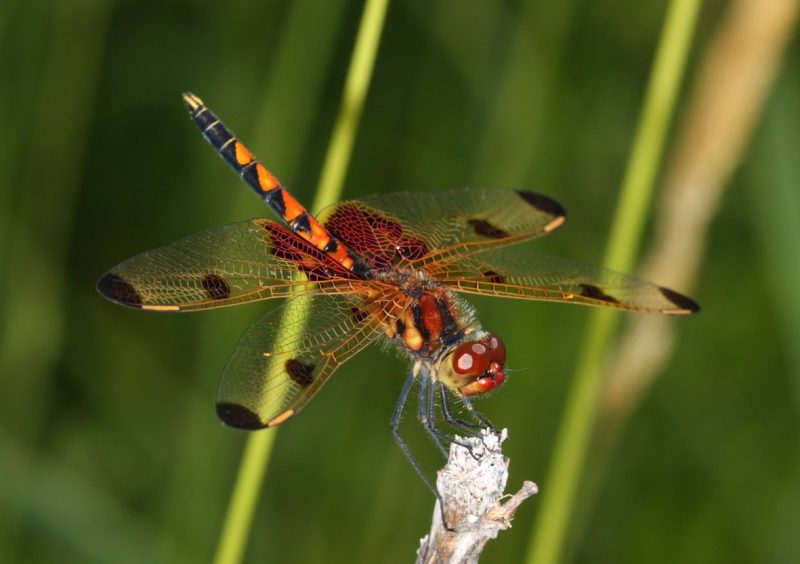
The Calico Pennant is a small, beautifully patterned dragonfly that is easily overlooked due to its delicate appearance but is widely distributed across Michigan. Males display a red abdomen with black heart-shaped markings, and their wings are sprinkled with small red and black spots. Females and juveniles are yellowish with similarly patterned wings, which provide excellent camouflage among grasses.
These dragonflies are typically found in open meadows near ponds, marshes, and shallow lakes. They prefer areas with abundant emergent vegetation and tend to perch on the tips of tall grasses. Calico Pennants are not aggressive and are often observed resting peacefully in groups. Their slow, fluttery flight is ideal for photographers and casual observers.
In Michigan, they are active from mid-June to early August and can be seen across much of the Lower Peninsula. A fun fact: Calico Pennants are sometimes used in biological surveys because their presence often indicates a healthy, low-pollution aquatic environment.
Swamp Darner (Epiaeschna heros)
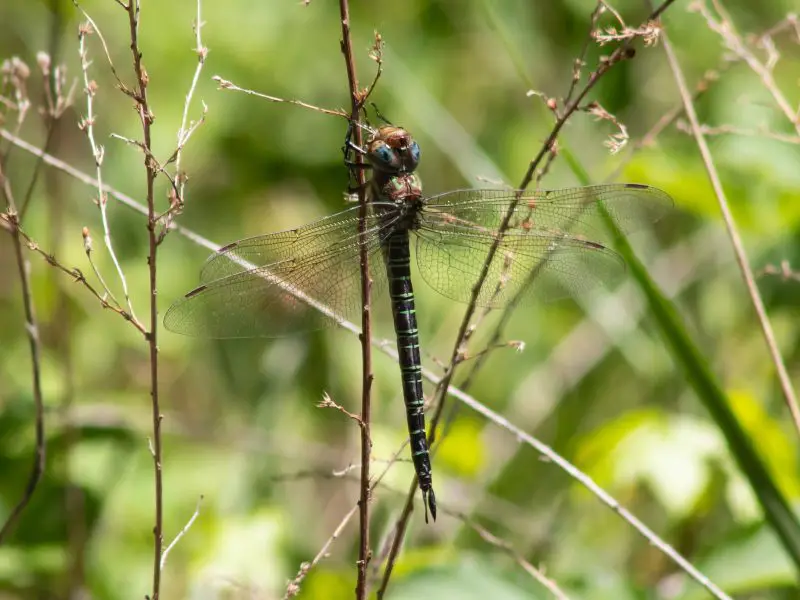
The Swamp Darner is one of Michigan’s largest dragonflies, reaching up to 3.5 inches in length. It has a striking appearance with dark, metallic green eyes, a brown thorax striped with green, and a long abdomen marked with vivid blue rings. Its large size and powerful flight make it one of the most dramatic dragonflies to encounter in the field.
Swamp Darners prefer wooded swamps, forested wetlands, and temporary woodland pools. They are strong fliers that often patrol high above the water or tree canopy but will sometimes descend to hover low over puddles or clearings. Unlike many dragonflies, females lay eggs in decaying wood or damp soil, often far from open water.
These dragonflies are active in Michigan from late May through August and are found throughout the state, especially in moist woodland areas. A fun fact: the Swamp Darner is one of the few dragonflies that regularly breeds in vernal pools—temporary bodies of water that dry up later in the year, allowing the species to avoid predators like fish.
Hine’s Emerald (Somatochlora hineana)
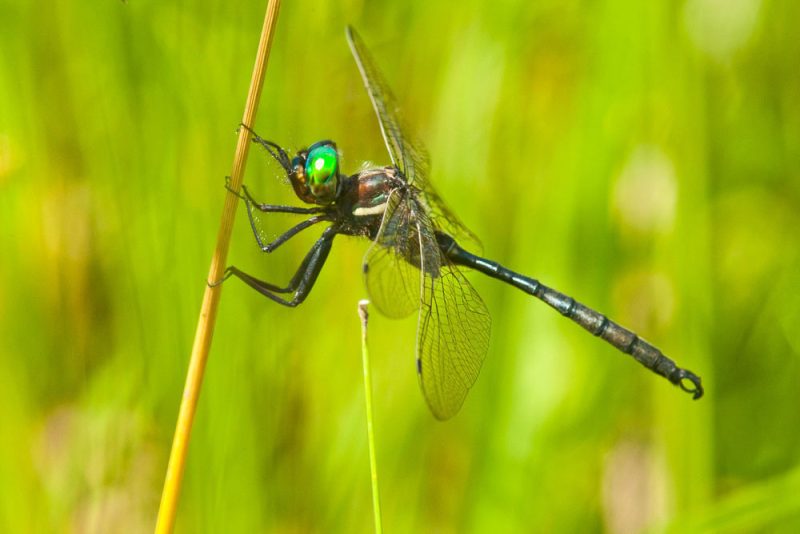
Hine’s Emerald is a rare and federally endangered dragonfly with a limited range that includes parts of the Upper Midwest, including a few protected sites in Michigan. It is a medium-sized dragonfly with metallic green coloration, bright green eyes, and a narrow, cylindrical abdomen. In flight, its shimmering appearance and fast movements make it difficult to spot.
This species prefers calcareous wetlands, fens, and spring-fed marshes with slow-moving, shallow water. It requires clean, undisturbed habitats with specific hydrology and is often restricted to areas with underlying dolomite bedrock. Hine’s Emeralds patrol long, looping routes over wet meadows and forest edges but rarely stray far from suitable breeding sites.
In Michigan, they are found only in a few carefully monitored locations in the northern Lower Peninsula. They fly from June through early August. A fun fact: Hine’s Emerald is the only dragonfly in the U.S. currently listed as federally endangered, and its presence is used as a key indicator of ecosystem health in certain Great Lakes wetland areas.
Elfin Skimmer (Nannothemis bella)
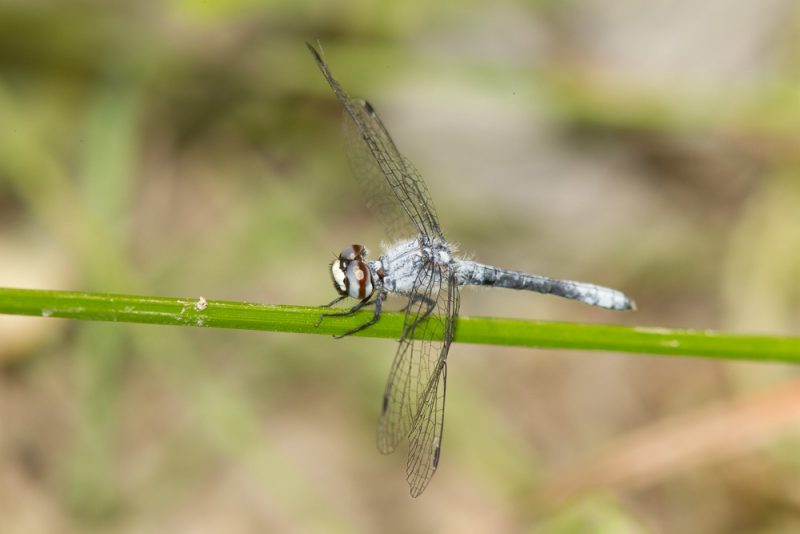
The Elfin Skimmer is the smallest dragonfly in North America and also holds the title of the tiniest dragonfly in Michigan. Adult males are a soft powdery blue, while females are yellowish with black striping, resembling a wasp or damselfly in flight. With a wingspan of only about 0.8 inches (2 cm), this species is so small that it’s often overlooked even when resting nearby.
These dragonflies are highly specialized and found in acidic, peaty wetlands such as sphagnum bogs and coastal plain ponds. They tend to perch low on mosses or sedges and fly weakly just above the ground, making them difficult to detect. Unlike larger, aggressive species, Elfin Skimmers are passive hunters and rely on ambush rather than high-speed chases.
In Michigan, they are extremely localized and typically appear from mid-June to late July. Their rarity and habitat specificity make them a highlight for dragonfly enthusiasts and conservationists. A fun fact: due to their tiny size and fragile structure, even mild breezes can push Elfin Skimmers off course, and they often land quickly after brief flights.
Red Saddlebags (Tramea onusta)
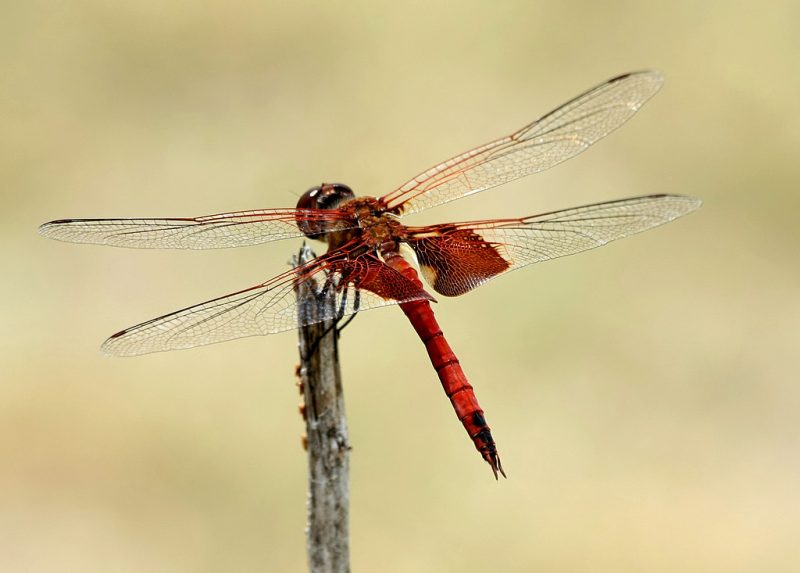
The Red Saddlebags is a medium-large dragonfly with distinctive red wing patches—called “saddlebags”—near the base of each hindwing. Males are a deep crimson with dark red facial features and brilliant ruby patches on the wings, while females are slightly duller and brownish. Their long, slender abdomen and translucent wings give them a graceful, kite-like flight.
Red Saddlebags are strong flyers often found gliding high over open fields, roads, and ponds. They are less tied to specific breeding sites and can appear far from water, especially during migration. When perching, they often hang from twigs or grass tips with their wings drooping downward. They feed on small flying insects caught during long aerial patrols.
In Michigan, Red Saddlebags are seen from July through October, mostly as summer migrants. They are more common in the southern parts of the state and can appear in large numbers during peak migration periods. A fun fact: Red Saddlebags are one of several dragonfly species known to migrate long distances, even crossing the Gulf of Mexico.
Black Saddlebags (Tramea lacerata)

The Black Saddlebags is another migratory dragonfly, easily recognized by the large black patches near the base of its hindwings and its dark, smoky body. Males and females look similar, both with black “saddlebags,” a dark brown abdomen, and large, clear wings that shimmer as they glide through the air.
This species prefers open habitats such as fields, parking lots, and ponds with few trees. Black Saddlebags are almost always seen in flight, often gliding in groups high above the ground. They rarely perch, but when they do, they hang with their wings held forward, giving them a bat-like silhouette. They feed on mosquitoes and gnats caught during flight.
In Michigan, Black Saddlebags appear from May to October, arriving with southern winds and sometimes lingering into the fall. They are common during migration and may be spotted almost anywhere during peak season. A fun fact: researchers use Black Saddlebags to track insect migration patterns with radar, as their long-distance flights are surprisingly predictable.
Variegated Meadowhawk (Sympetrum corruptum)
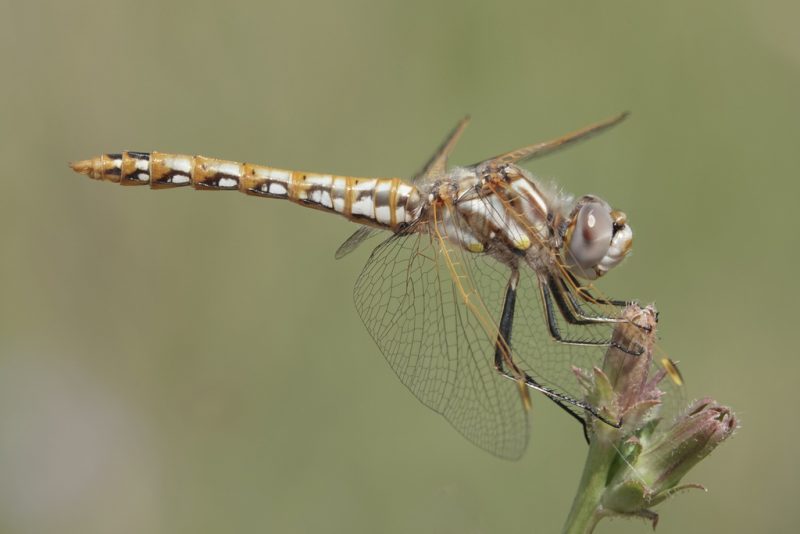
The Variegated Meadowhawk is a medium-sized, colorful dragonfly known for its beautiful mottled patterns and migratory behavior. Males are vibrant red with creamy pink and gold markings, while females are tan to light brown with similar mottling. The wings often have amber or rusty shading, especially near the base.
This species frequents open, weedy ponds, irrigation ditches, and even arid fields far from water. It is an agile flier and not particularly territorial, often appearing alone or in loose groups. They perch frequently on rocks, fences, and bare soil, soaking up the sun between brief hunting flights. They are not aggressive but are fast, efficient predators.
In Michigan, Variegated Meadowhawks appear irregularly from late summer through October, often as part of migratory influxes from the southwest. Their presence can vary greatly year to year. A fun fact: this species is known to migrate thousands of miles, and individuals tagged in western states have been found as far east as the Great Lakes.
Spot-winged Glider (Pantala hymenaea) and Wandering Glider (Pantala flavescens)
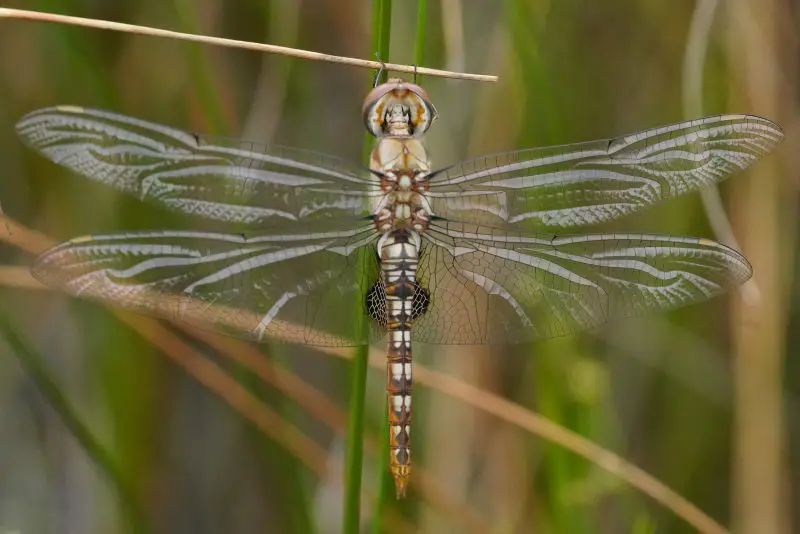
Both the Spot-winged Glider and Wandering Glider are migratory dragonflies known for their exceptional flying endurance and globe-spanning travel. The Spot-winged Glider is larger and has a reddish-brown body with a distinctive dark spot near the base of each hindwing. The Wandering Glider is more uniformly yellow or golden, with a lighter, slightly shorter build and clear wings.
These dragonflies inhabit temporary pools, roadside ditches, and ephemeral wetlands, making them well-suited to nomadic and migratory lifestyles. They are almost always seen in flight, soaring high above fields or over open water. Unlike many other species, they are rarely territorial and sometimes form large, mixed-species swarms with other gliders and saddlebags.
In Michigan, both species are summer and fall visitors, appearing from June to October, depending on weather patterns. They are more frequently seen in southern parts of the state, but their strong migratory nature means they can appear almost anywhere. A fun fact: the Wandering Glider holds the world record for the longest insect migration—over 11,000 miles round-trip—across the Indian Ocean and multiple continents.
FAQs About Dragonflies in Michigan
What time of year are dragonflies most active in Michigan?
Dragonflies in Michigan are typically most active from late May through early October, with peak activity occurring in the warm summer months of June, July, and August. Some species, like the Common Green Darner, appear as early as April, while others such as the Autumn Meadowhawk can still be seen flying into November on mild days.
Where are the best places to see dragonflies in Michigan?
Dragonflies are commonly found near wetlands, ponds, lakes, marshes, slow-moving streams, and even roadside ditches. Some of the best places to observe them include state parks, nature preserves, and bog habitats with open sunlight and aquatic vegetation. Look for dragonflies perching on tall grasses or flying low over the water’s surface.
What do dragonflies eat?
Dragonflies are skilled aerial hunters that feed on a wide variety of small flying insects, including mosquitoes, midges, gnats, flies, and even smaller dragonflies or damselflies. Their diet helps control pest populations, making them beneficial to both humans and ecosystems.
Are dragonflies dangerous to humans?
No, dragonflies are harmless to humans. They do not bite or sting, and while they may fly close out of curiosity, they pose no threat. In fact, they’re helpful to have around, especially in summer when mosquito populations rise.
Do any dragonflies migrate through Michigan?
Yes, several species, including the Common Green Darner, Black Saddlebags, Red Saddlebags, and Wandering Glider, are migratory. These species travel north into Michigan during the summer and head south in the fall, sometimes forming large migratory swarms.
How can I attract dragonflies to my garden?
To attract dragonflies, create or maintain a small pond or water feature with native aquatic plants and sunny, open space. Avoid using pesticides, as dragonflies are sensitive to chemicals and rely on insect prey for food. Shallow water, floating vegetation, and sunlit areas all help provide an ideal habitat.
What’s the difference between a dragonfly and a damselfly?
Dragonflies are generally larger, more robust, and hold their wings out flat when resting, while damselflies are smaller, slender, and typically fold their wings over their body when at rest. Dragonflies also have eyes that touch or nearly touch, whereas damselfly eyes are separated.


